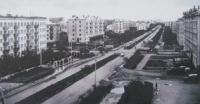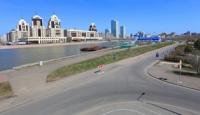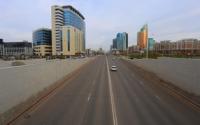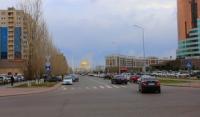You are here
History of renaming streets of Astana.





Vacations & Tours in Kazakhstan.
“Worldly goods, being deception, falsehood and fiction, are inherently inconsistent”
As-Samarkandi Muhammad ibn Ali.
Guided walks and Travels of Kazakhstan.
In recent years, disputes about the names of the capital's streets have not ceased. Astana is growing rapidly, with dozens of new streets appearing in the city every year. For this reason, their names are a relevant and burning topic.
In early November, deputies of the capital’s maslikhat decided that one of the main streets of the left bank - Orynbor - was called incorrectly and renamed it Migilik El. However, the street in honor of the first capital of Kazakhstan will still be only in the constructed area, which now bears the design name E10.
On this wave, a Dixinews.kz correspondent found out what the streets of Astana were called at different times in history and what has changed since then.
The old part of the city of Nur Sultan.
It is difficult to call such a capital Astana, however, few people know that some streets of the city have names since the 20s of the XX century. Of course, due to circumstances, they have changed their names more than once, so we suggest you plunge into the history of your native capital.
One of the oldest avenues in the “old” city is Zhenis Avenue. It starts from T. Ryskulov Street, intersects with Kenesary, S. Seifullin Streets and Abay Avenue, Bogenbai Batyr Avenue, ends at I. Esenberlin Street. Length - 3304.4 meters.
Until 1920, the street bore the name - Fortress. Obviously, somewhere around this street was Akmola fortress. However, since 1920, the Fortress was renamed Freedom Street. In 1934, it became known as Sportivnaya, and already in 1965, by the 20th anniversary of the Victory, - Victory Street.
It is known that during the war the residents of Akmolinsk saw off and met soldiers on this street. In addition, it directly leads to the station. The current name Zhenis Avenue was assigned in 2007.
Another of the most “famous” streets of the right bank is Saken Seyfullin Street, which until 1920 was called Stepnaya. Since 1920, it was renamed into the street of Moses Uritsky, a famous revolutionary at that time. Since 1934 the street was called Revolutionary. Since November 1997 - Saken Seyfullin street.
Abay Avenue is one of the longest. Length - 5280 meters. At one time, the street was called Church Street, possibly because it was on this street that one of the first mosques in Akmolinsk was built. In 1895, it was built by a Tatar merchant, so the people nicknamed it “Tatar” or “green”.
With the establishment of Soviet power, the street became main and was named - Lenin. Since November 1997, it was renamed Abay Street.
Street I. Esenberlina until 1920 was called Stara. Since 1920, it began to bear the name - Narodnaya, already in 1934 the street was named after the revolutionary Sergei Kirov, and in 1951 - the revolutionary Vyacheslav Molotov. Since 1957, the street received the "famous" name in the 1980s and 1990s - Monina. In 1997, it was renamed Akzhayik, and in 2007 - Ilyas Yesenberlin.
The length of Bogenbai Batyr Avenue is 3611.7 meters. It starts from N. Tlendiev Avenue and intersects with the streets Zheltoksan, Beibitshilik, M. Auezova, S. Toraigyrova, Sh. Aimanova, Zh. Aymauytova, Sh. Ualikhanova.
Until 1991, the avenue was called Pyatiletki Street. In June 1991, the city authorities dubbed it Bogenbai Avenue, and already in 2004 - Bogenbai Batyr Avenue.
Another “oldest” street in Astana is Beibitshilik. Until 1920 it bore the aristocratic name of the Gostiny Dvor. Since 1920, she was given the name of A. Lunacharsky, from 1929 she received the name Proletariat. Since 1951 it was renamed to Mira Street, since 1998 to Beibitshilik Street.
The street named after Mukhtar Auezov until 1920 was called Central. Since 1920, it was called the Republican, and then - October. It got its current name since 1997.
Zheltoksan Street until 1997 was called Komsomolskaya.
Aliya Moldagulova Street since 1965 was called May 9th Street. Since 2008, it was renamed K.
Zhalayyri Street, and later, in the same year, in Aliya Moldagulova.
Until 1999, Karasay Batyr Street was called May Day.
Otyrar street until 1937 bore the name of Saken Seyfullin. Since 1937, she was given the name Voroshilov, and since 1961 - S. Ordzhanikidze. Since November 1997, the street got its current name.
The street of the Constitution in the old part of the city since 1956 was called the street of the Soviet Constitution. In 1997, it was renamed Constitution Street.
Zataevich Street until 1957 bore a beautiful name - First Zarechnaya. In 1957 it was renamed G. Drizge Street. Since November 1997, it received the name of A. Zataevich.
Goethe Street until 1984 was called Elevator. Since 1984, received its current name.
Alibi Dzhangildina street until 1934 was called - Forest. Since January 1967, she was named after A. Dzhangildin.
Y. Street. Dukenula until 1934 was called Zagorodnaya. Since December 1961 it received a new name - Friendship Street. In 2007, she was given the name Y. Duchenules.
Since 1967, the street of J. Omarov was named after the 50th anniversary of October. Since June 1997 - J. Omarova.
Until 1997, Birzhan-sal Street was called Vokzalnaya.
Kenesary Street in 1920 was called the Big Bazaar. This name was speaking, since it was there that the bazaar rows were and fairs were held. By the way, in our time, fairs and festivities are also held on the square in front of the akimat. In 1934, the street was renamed Karl Marx. In 1997, the street was given the current name.
The Republic Avenue, beloved by all, starts from Zh. Tashenov Street, intersects with Zhanibek Tarkhan, A. Imanov, Kenesary, Otyrar, S. Seifullin, A. Dzhangildin, Y. Dukenuly, A. Moldagulova and Abai Avenues, Bogenbai Batyr.
Length - 4159 meters. Since 1979 it was called Tselinnikov Avenue. In 1997, it was named Prospect of the Republic. In December 2007, the avenue was extended and Pushkin Street was added (from Goethe St. to Seifullin St.).
Another of Astana's longest avenues is Saryarka Avenue. It starts from Shyganak street, ends on Beresterek street. It intersects with the avenues Abay, Bogenbai batyr, Kenesary, T. Bigeldinov, S. Seifullin, A. Dzhangildin, Zhambyl streets. Length - 3191.5 meters.
Until 1929, the street was called Kladbischenskaya. By the way, in the capital there are many legends that it was once a large cemetery in the place of this street. Since 1929, the street was renamed and named Delegatskaya. Since November 1997, the street was named Saryarka, and in 2004 - the status of the avenue.
Alikhan Bukeikhanov Street until 1920 was Trading. Since November 1920, she was named after N. Bukharin, and in 1929, the participants in the movement for the rights of workers Sacco and Vanzetti. In November 1997, a small street in the center of the "old" Astana was named after A. Bukeikhanov.
However, in early November 2016, it became known that a large street named after a public figure known in the history of Kazakhstan will appear on the left bank of the capital. The former Bukeikhan street will be named after Azerbaijan Mambetov.
Sh. Ualikhanov street until 1957 was called Labor. Since 1957 it was renamed Avdeeva. The current name of the street was given in November 1997
The street Agybay Batyr until 1934 was called Kenesarinskaya. Since 1934 it was renamed the International, in 2007 - in Agybay Batyr.
Since 1955, Sh. Imanbaeva Street was called Soviet. In August 1962, the street received its current name.
The street Zhanibek Tarkhan from 1957 to 1997 was called - Smokotina.
Street E. Brusilovsky received its current name in 1999. Earlier, in 1967 it was called Red Cross Street.
Sembinova Street was previously called - School.
Street T. Begeldinova got its name in July 1993. Since 1929, it has been called Communist.
B. Beisekbaev Street was so named in July 1999. Since 1956, the street was called after Zhukovsky.
New Akmola.
In the late 80s of the XX century Tselinograd began to grow actively. New microdistricts, trading houses, educational institutions, parks, squares, etc. appeared in the city. In 1992, the city was named Akmola.
One of the main symbols of the new Akmola was Abylai Khan Avenue, which until 1997 was called Student Avenue. By the way, there was the trading house of the same name, the main universities of the city and their hostels.
Later, already in the years of Independence, B. Momyshuly Street appeared, which is also called one of the main ones. The former name of the street is the 13th highway. It starts from Sarayshyk Street, intersects with Kyzylaray, Syrymbet, Korday, M. Tolebaev Streets, M. Zhumabaev and Tauelsyzdyk Avenue, and is downloaded on Abylay Khan Avenue. Length - 3958.7 meters.
Prospect Tauelsyzdyk. The former name is Manas Avenue. It starts from Zh. Tashenov Street, intersects with B. Momyshuly Avenue, Kazhimukan, B. Maylina streets. Length - 1095.8 meters.
Baraeva Street got its name in January 1987. It should be noted that this is one of the few streets that has not been renamed.
In 1987, Kazhymukan Street got its name. Then they called it Hadji Mukan Munaitpasov Street. Later, in 2007, the street got its current name.
Kravtsova Street is also one of the few who did not comprehend the renaming. It got its name in October 1987.
Since 1989, Vavilova Street appeared in the capital. In December 2007, it was renamed B. Maylin Street.
The new A. Pushkin Street was “formed” in the ENU area in 2007 by combining L. Gumilyov and Mozhaisky Streets.
Until 1999, Zhubanova Street was named after D. Likhachev.
Zh. Tashenova Street also had a different name until 1999 - Polevaya.
In 2003, Tsiolkovsky Street was renamed. She received the name of A. Yanushkevich.
The left bank of the city of Nur Sultan.
With the transfer of the capital to Akmola and the renaming of the city in Astana, the life of the provincial town changed dramatically. The city began to be built up at an unbelievable speed, people from all regions of the country were drawn to the new capital. Consequently, new streets appeared. In the early 2000s, routes leading from the city were renamed into avenues.
One of the longest avenues in the capital is considered to be Kabanbay batyr avenue. It starts from the Karaotkel bridge, intersects with the streets of Saraishik, D. Kunaev, Dostyk, Kerey and Zhanibek Khandar, Almaty, Turar Ryskulov, ends on the airport circular road. Length - 16090 meters.
Until 2001, the avenue was considered the highway, which was called Christmas. Since 2001, the prospectus was named Kabanbay, and in 2004 - Kabanbay batyr.
The second longest avenue is Turan, which used to be a continuation of Saryarka Avenue. It starts from Saryarka Avenue and ends on the airport circular road. Length - 16,000.0 meters. Turan is the ancient name of the Turkestan Territory.
One of the most important streets of the left bank is Orynbor, which will soon be called Mugilik El. It is on this street that the House of Ministries, the General Prosecutor's Office, the financial center and the Arc de Triomphe are located - a symbol of Independence.
Length - Kunaev Street - former name - Street No. 1. It starts from Turan Avenue, intersects with the streets of Akmeshit, Turkistan. Length - 2250.2 meters.
Sarayshik Street - the former name is Street No. 12. It starts from B. Momyshuly Avenue and ends at Turan Avenue. Length - 2409.8 meters.
Sauran Street - former name 78. It intersects with the streets of Syganak and Almaty. Length - 5666.9 meters.
Syganak Street is the former name of the main street number 19. Length - 3074.8 meters.
Dostyk Street - the former name is street No. 2. Length - 2299.5 meters.
Kerey Street and Zhanibek Khandar - the former name is street number 23. Length - 5865 meters.
Street Sh. Kaldayakova - the former name is boulevard No. 23-1. Length - 6690 meters.
Authority:
https://dixinews.kz/articles/zhizn/25525/
The material was prepared with the support of the Astana city archive and the National library of the Republic of Kazakhstan. Information taken from books: "Streets of Astana", Astana - 2009. "Streets of Astana". Sardak, Almaty, 2011.
Photos by
Alexander Petrov.







